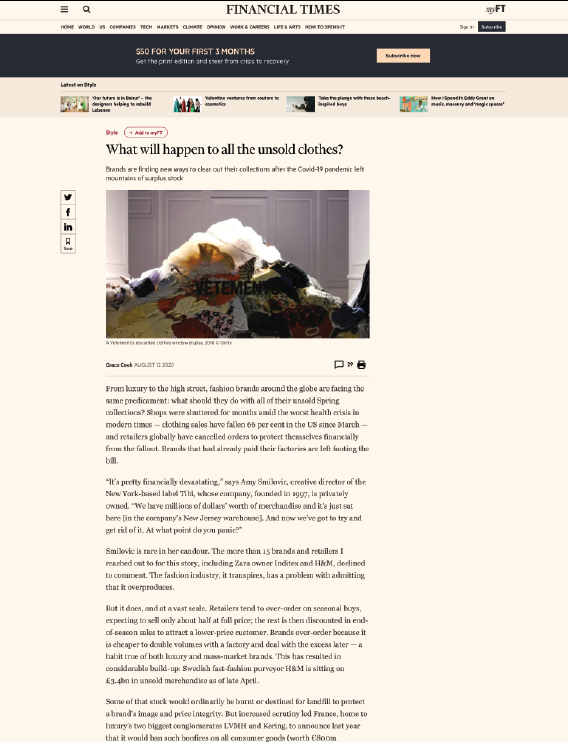Brands are finding new ways to clear out their collections after the Covid-19 pandemic left mountains of surplus stock
From luxury to the high street, fashion brands around the globe are facing the same predicament: what should they do with all of their unsold Spring collections? Shops were shuttered for months amid the worst health crisis in modern times — clothing sales have fallen 66 per cent in the US since March — and retailers globally have cancelled orders to protect themselves financially from the fallout. Brands that had already paid their factories are left footing the bill.
“It’s pretty financially devastating,” says Amy Smilovic, creative director of the New York-based label Tibi, whose company, founded in 1997, is privately owned. “We have millions of dollars’ worth of merchandise and it’s just sat here [in the company’s New Jersey warehouse]. And now we’ve got to try and get rid of it. At what point do you panic?”
Smilovic is rare in her candour. The more than 15 brands and retailers I reached out to for this story, including Zara owner Inditex and H&M, declined to comment. The fashion industry, it transpires, has a problem with admitting that it overproduces.
But it does, and at a vast scale. Retailers tend to over-order on seasonal buys, expecting to sell only about half at full price; the rest is then discounted in end-of-season sales to attract a lower-price customer. Brands over-order because it is cheaper to double volumes with a factory and deal with the excess later — a habit true of both luxury and mass-market brands. This has resulted in considerable build-up: Swedish fast-fashion purveyor H&M is sitting on £3.4bn in unsold merchandise as of late April.
Some of that stock would ordinarily be burnt or destined for landfill to protect a brand’s image and price integrity. But increased scrutiny led France, home to luxury’s two biggest conglomerates LVMH and Kering, to announce last year that it would ban such bonfires on all consumer goods (worth €800m annually) by 2023. Designers need to find new ways of getting rid.
Burberry is so far the only major luxury label to announce a strategy for its SS20 overstock, which will be discounted at outlets and in staff sales, or else donated to charities or recycled. The British brand came under fire for disclosing in its 2018 annual report that it burnt £28.6m of unsold merchandise; a few months later, after a flurry of negative press, it announced it would ban the practice altogether.
Burberry has outlets in Bicester Village and Cheshire Oaks in the UK; other outlet hotspots such as Woodstock, New York, will benefit from this glut.
But while bigger brands can shift stock to their cut-price shops, small designers need to take matters into their own hands. The first line of attack was an early flash sale. London-based Rejina Pyo offered discounts in April — 20 per cent off a pair of strappy sandals, 30 off a tiger-print skirt and 40 off a woven bucket bag — for 24 hours each time.
Petar Petrov, meanwhile, held a private shopping night in his Vienna studio when lockdown lifted in June; Petrov was left with €1m of merchandise from cancelled orders and — without his own ecommerce platform or shop — no means to sell it. “We offered 20 per cent off and sold 150 pieces,” he says.
He later did another event in Munich, but with 40 per cent discounts. Today, he’s got 400 items left in a warehouse to shift, but is worried about hosting more immediate events. “We need to not look desperate.”
Retailers, however, are offering drastic discounts; at Saks, a flowery Rosie Assoulin blouse is a snip at $334. Its original retail price was an eye-watering $1,395. Net-a-Porter is selling tops by Ganni and denim bombers by Stella McCartney for 70 per cent off. Matches Fashion has slashed prices by up to 80 per cent. (For anyone in the market to spend, now is a pretty good time; I bagged a much longed-for marigold-yellow puffed-sleeve dress from Rejina Pyo’s sale edit for Vestiaire Collective for less than half price. With any luck, someone will invite me to a fancy party next year at which I can wear it.)
It’s financially devastating. We have millions of dollars’ worth of merchandise and it’s just sat here
Doing a sale edit for a resale site such as Vestiaire Collective is a clever way of discounting without detracting from the full-price merchandise. In a similar vein, Harrods has set up an outlet in Westfield shopping centre in London.
Stockholm-based sneaker brand CQP established a separate sale site titled CQP Archive in June, with more than 30 styles from current and previous seasons. “It’s a way to sell overstock without cannibalizing on our [full-price] business,” says founder Adam Lewenhaupt.
The collections still sitting around by the end of summer will wind up in a sample sale, according to Katie Holland, founder of off-price events company Showcase. During lockdown, its new online arm held sales for brands such as Shrimps and Erdem. “The end-of-year sample sales will be bigger than they’ve ever been — there’ll be more designers needing to do them and more units to sell,” she says.
Yet online sales are “logistically complicated”, says Nikole DeSantis, commercial director at Shrimps, since brands have to accept returns from online sample sales. “But collaborating with a third party with its own large database is a useful way to reach customers that might not usually shop with us.”
Fashion designer Rejina Pyo, who started holding flash sales in April © Linda Nylind/eyevine
Business is booming, too, for MadaLuxe Group, the stealthy New York-based middleman company that buys out-of-season inventory from brands and discreetly filters them through to discount stores such as TJ Maxx globally. “Our business has planned up 25 per cent from what our original projection was for this year,” chief executive Adam Freede tells me on the phone from San Francisco. The company buys “packages” from brands that — at full retail value — can span anywhere from $1m to $400m.
Supply is outstripping demand. “You can get major price breaks for helping brands out that need cash and need to turn inventory,” says Freede. MadaLuxe offers each brand a proposal to shift stock across territories, holding it within its own warehouses until it is sold on to discount stores. It sounds like an appealing deal. But Smilovic says that one company offered to buy $170,000 of wholesale inventory for a sum that was “pence” over breaking even — leaving her a $17,000 profit. She told me it wouldn’t even have paid her electricity bills. Yet for many young brands with spiraling costs, that monetary injection will prove a lifeline. “We’re sitting in the wings with cash,” says Freede.
For brands that aren’t hard-up, donating overstock makes for good PR. Italian designer Brunello Cucinelli, the publicly traded king of cashmere with a market value of €1.7bn, says he will gift clothing worth €30m to “various charities globally”. Petrov says he might give some to local students to play around with. And Smilovic donated more than 900 dresses to frontline workers in April.
“Every organization has a duty to have a corporate and social responsibility,” says Fionnuala Shannon, executive director of the Dress for Success charity, which gives office-appropriate clothing — and interview skills — to vulnerable women worldwide to help them get back into the workplace. Net-a-Porter is one of its biggest partners — last season, it donated 800 garments and 2,500 cosmetic items.
Shannon is hoping some of the current surplus will wing its way to her. “There’s enough fashion in the world to clothe six generations of the world’s population; it’s a disgrace,” she says. “There’s a mountain of clothes. No matter how they try to sell it, they’re not going to be able to claw back all profits.”


